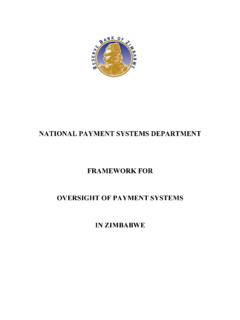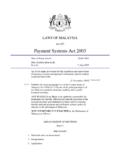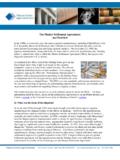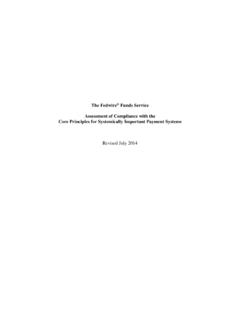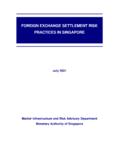Transcription of Payment and Securities Settlement Systems in …
1 FINANCIAL FLAGSHIP. Payment AND Securities Settlement . Systems IN THE MIDDLE EAST AND. NORTH AFRICA. MASSIMO CIRASINO AND MARCO NICOL *. JUNE 2010. The World Bank *. DISCLAIMER - The current version of this chapter is based on the country assessments undertaken within the Arab Payment Initiative (API), the World Bank Global Payment Systems Survey 2008 and the Arab Monetary Fund (AMF) Payment and Settlement Systems in the Arab Region Statistical Booklet 2009 . This chapter is in the process of being updated with the responses to the World Bank Global Payment Systems Survey 2010; thus, some information may be outdated or incomplete and not reflect the current status in the country. Abstract This chapter provides a comprehensive overview of Payment and Securities Settlement Systems of MENA countries, from which a number of high-level recommendations have been drawn.
2 The chapter is organized by topic, covering issues related to legal framework, large value Payment Systems , retail Payment Systems , Securities Settlement Systems , cross-border payments and remittances, Payment Systems oversight and cooperation. The main resources used as references are the country assessments undertaken within the Arab Payment Initiative (API), the World Bank Global Payment Systems Survey 2008 and the Arab Monetary Fund (AMF) Payment and Settlement Systems in the Arab Region Statistical Booklet 2009 . 2. Table of Contents Executive Summary .. 5. Main findings .. 6. Abbreviations .. 8. 1. Overview .. 9. 2. Legal and regulatory framework .. 10. Context .. 11. Observation .. 11. 3. Large Value Payment Systems_Toc280695014 .. 18. Context .. 16. Observation .. 17. 4. Retail Payment Systems .. 21. Context.
3 21. Observation .. 21. 5. Cross Border payments and Remittances .. 25. Context .. 25. Observation .. 26. 6. Securities Settlement Systems .. 27. Context .. 27. Observation .. 30. 7. Oversight and cooperation .. 35. Context .. 35. Observation .. 38. 8. Concluding Remarks.. 40. Annex 1 Country Tables .. 43. Legal and regulatory framework .. 43. Large value Payment Systems .. 49. Retail Payment Systems .. 58. Securities Settlement Systems .. 66. Cross-border payments and remittances .. 70. Oversight and cooperation .. 73. 3. Figures: Figure 1 - Cashless retail Payment transactions per capita for year 2006 22. Tables Table 1 - Pieces of legislation with explicit references to Payment Systems .. 13. Table 2 - Payment system concepts covered in the legal framework of selected MENA countri 14. Table 3 - Systems for Large-Value Fund 18.
4 Table 4 - Resilience and business continuity .. 19. Table 5 - Cashless Payment transactions in selected Arab countries for year 2006 .. 22. Table 6 - Statistics on availability of ATM and POS terminals .. 24. Table 7 - Payment cards in circulation (per 1,000 inhabitants as of 2006) .. 25. Table 8 - Central bank-operated Securities registries,depositories and SSSs .. 32. Table 9 - Private sector/exchange-operated Securities depositories and SSSs .. 33. 4. Executive Summary The payments and Securities Settlement system is the infrastructure (comprised of institutions, instruments, rules, procedures, standards, and technical means) established to effect the transfer of monetary value between parties discharging mutual obligations. A Securities clearance and Settlement system can be considered as part of the overall Payment mechanisms of a country in that it satisfies the main features of this overall definition.
5 In this case, the exchange of financial value consists both of the exchange of Securities (equity, fixed income, or derivatives) and the exchange of liquid funds (usually sight deposits). An efficient system reduces the cost of exchanging goods and services, and it is indispensable to the functioning of the interbank, money, and capital markets. As many countries are embarking on projects to reform and modernize their payments and Securities Settlement Systems , domestic policymakers are faced with the formidable task of how best to design Payment system infrastructures in fast-changing technological and institutional environments. These tasks become increasingly complex as competition and innovation require an always changing combination of efficiency, reliability, safety, and system stability in the provision of Payment services to larger numbers of individual users and institutions.
6 This chapter provides a comprehensive overview of Payment and Securities Settlement Systems of MENA countries, from which a number of high-level recommendations have been drawn. The chapter is organized by topic, covering issues related to legal framework, large value Payment Systems , retail Payment Systems , Securities Settlement Systems , cross-border payments and remittances, Payment Systems oversight and cooperation. The main resources used as references are the country assessments undertaken within the Arab Payment Initiative (API), the World Bank Global Payment Systems Survey 2008 1 and the Arab Monetary Fund (AMF). Payment and Settlement Systems in the Arab Region Statistical Booklet 2009 . Individual Arab countries are undertaking Payment system reforms, including as a result of the Arab Payment Initiative (API), and are working towards increased regional integration.
7 The objective of the API, launched in 2005, is to describe and assess the Payment Systems of the countries of the Middle East and North Africa (MENA) Region with a view to identifying possible improvement measures in their safety, efficiency and integrity. Within the API, international teams of Payment system experts have been deployed to Bahrain, Djibouti, Egypt, Jordan, Lebanon, Morocco, Palestine, Qatar, Syria, Sudan, UAE, and Yemen. In addition to individual country reforms, there is a growing interest in the Arab region, as in other regions of the world, towards the possible efficiency gains that could be achieved by adopting integrated frameworks for regional Payment and Securities Settlement Systems . 1. The World Bank, Payment Systems Worldwide: A Snapshot. Outcomes of the Global Payment Systems Survey 2008 , Washington DC, June 2008.
8 5. Main findings The legal and regulatory framework for Payment and Securities Settlement Systems in the Arab region is one of the weakest in the world. Although there are usually basic laws affecting general payments and their Settlement , such as central bank laws, banking laws and, in some cases, even Securities laws, specific Payment Systems laws are not commonly present among the institutional arrangements for payments in Arab countries. Consequently, key issues are not adequately addressed in the payments system frameworks of the countries in the region. In particular, in many MENA countries the legal framework does not cover fundamental Payment system concepts, such as Settlement finality, bilateral and multilateral netting, and non-existence of zero-hour rules. Until just recently, most MENA countries used exclusively cheques to initiate all large value payments .
9 Cheques are still used for large-value payments in virtually all the national payments Systems in the region and remain the principal instrument for large-value payments in one out of three countries in the region, according to the World Bank Global Payment Systems Survey. In these countries, cheque usage is driven mainly by commercial activity since cheques are an established Payment instrument with reasonably sound legal support for their use. For this reason, the countries in the region with basic and more developed national payments Systems have well established and, in some cases, relatively efficient domestic currency cheque clearing and Settlement Systems . To increase efficiency and reduce risk related to cheque-based Systems , many central banks in the region have established RTGS Systems to settle large-value inter-bank payments .
10 However, several RTGS Systems need to be updated and made more efficient, so that all relevant market participants use them intensively. This should also facilitate a reduction in the use of cheques for large-value payments . The MENA region is characterized by a heavy use of cash and cheques, which keeps retail payments far from optimal from the point of view of efficiency and risk control. The infrastructure to process retail Payment instruments and key policy decisions that affect the safety, soundness and efficiency of the services provided is considered insufficient in the majority of the MENA countries. Central banks and all stakeholders in the retail arena must work together on a clear strategy to promote the intensive use of retail electronic Payment instruments and reduce the importance of cheques. The adequacy of remittance Systems is variable in the GCC countries.













